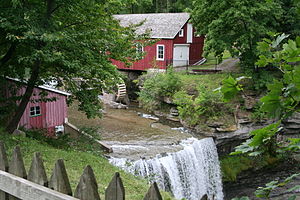Image by MustangJoe from Pixabay
Due to the regulating effects of Lake Ontario, Lake Erie, and the Niagara Escarpment to the south, St. Catharines has a different microclimate than most of Southern Ontario. St. Catharines is located in the humid continental climate region, which is characterized by four distinct seasons with wide temperature ranges and heavy snowfall in winter.
The abundance of vineyards in this region is a result of the favorable climate, which also contributes to the great range of wines that can be found here. On many spring afternoons, the city’s lakefront is also micro-cooled and contains frequent fountains. It will occasionally get warm and muggy, but this only happens a small proportion of the time.
Summer high temperatures in this location typically reach 27 degrees Celsius (81 degrees Fahrenheit). Thunderstorms are more frequent in southern Ontario in the summer than further west, but they are frequently less powerful because to the dilution of the lakes that surround the region.
This is commonly ascribed to the generally dry summers that offer mostly clear days and winter thaws. However, due to climate change brought on by our reliance on fossil fuels and other human activities, thunderstorms can occasionally result in heavy downpours and localized flooding.
A lake-effect snowfall is a heavy snowfall produced when cold winds blow across warm, moist air over a sizable body of water. These winter storms can foster the perfect conditions for thunderstorms because they are frequently at their strongest in the fall or spring. In the relatively dry summer months, thunderstorms require less fuel to create heavy rain and high winds, fostering this type of weather.
The Niagara Peninsula has been created by an intricate and extensive history of glacial episodes, which has resulted in a similarly intricate soil stratigraphy in the region where the city of St. Catharines is currently situated.
On July 10, 1936, a temperature of 40.0°C was recorded as the highest ever. and on February 18, 1979, the lowest temperature ever measured was -25.7°C. Previously, Glacial Lake Iroquois, which eventually poured clay on the ground between Lake Ontario and the Escarpment, was located at the bottom of what is now Catharines, at the top of the Niagara Escarpment.
Evidence found by researchers suggests that this area was formerly home to a sizable city before European invaders came to occupy it. These components have led to the soil in the city becoming one that is especially suited for fruit cultivation and is capable of producing grapes that are used to produce award-winning wines.
Just west of the city’s center is Henry of Pelham Winery, one of the most well-known wineries. Along with offering high-quality wine, they also offer a range of open-to-the-public wine-related tours. Two more wineries situated in the heart of Pelham’s western part are Hernder Estates and Harvest Estates.
Since 1829, four separate canal systems have been cut into the city’s topography, the first of which was the Welland Canal. The majority of the city’s eastern boundary is formed by the fourth and current canal. The city’s initial three canals, parts of which were alongside the current Highway 406, as well as those close to Lake Street and the QEW, have been mostly buried.




